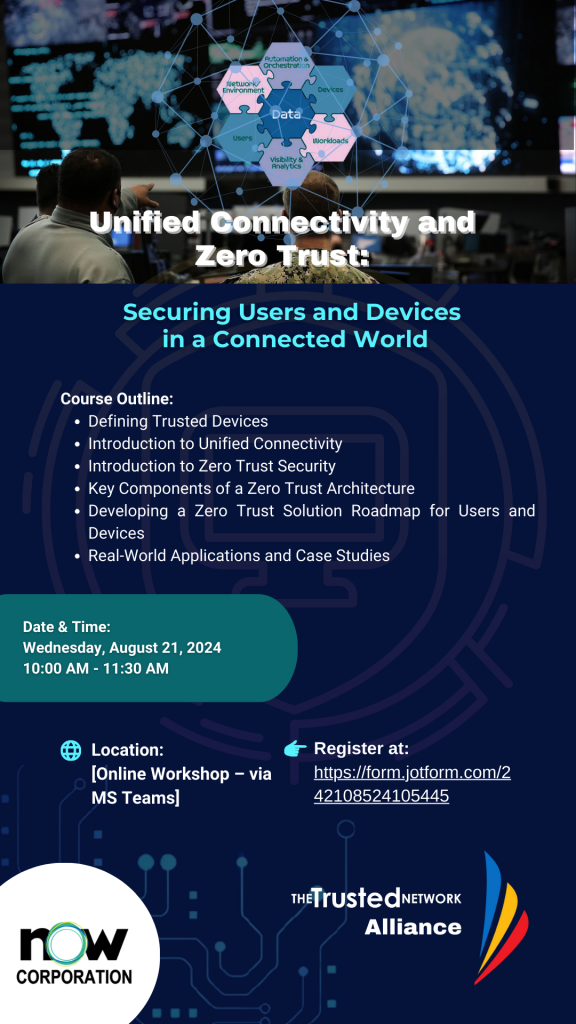Highlights from the TNA Knowledge Networks Event!
Watch as IT leaders and tech visionaries from top industries gathered to explore groundbreaking cybersecurity solutions, including FortiSASE and Dell Backup in the recently concluded TNA Knowledge Networks event last October 24, 2024 at the Ascott Makati. Dive into expert insights on safeguarding data and protecting remote workforces with zero-trust frameworks.
Thank you to everyone who joined us on this journey to secure the future of digital enterprise!
ncorp_admin
MEDIA RELEASE
Immediate Release
May 20, 2025
Critical Advisory Issued for BPOs and U.S.-Affiliated Companies Operating in the Philippines
NOW Corporation (PSE-listed), holder of a significant 24.3% stake in NOW Telecom Company, Inc., draws attention to a critical Public Advisory recently disclosed to the Philippine Stock Exchange, originally issued by the Trusted Network Alliance—an initiative spearheaded by NOW Telecom in collaboration with U.S. government-supported cybersecurity and digital infrastructure programs.
This advisory underscores significant business continuity and legal risks emerging from recent regulatory actions by the Philippine National Telecommunications Commission (NTC), specifically its sudden and unexplained cancellation of NOW Telecom’s license despite its status as the sole U.S.-certified “clean network” provider in the country.
The Trusted Network Alliance strongly advises all Business Process Outsourcing (BPO) organizations and U.S.-affiliated businesses operating within the Philippines to immediately conduct a comprehensive review of their telecommunications and IT infrastructure contracts. The advisory highlights:
- Potential exposure to U.S. federal and state regulatory compliance violations due to utilization of non-compliant or banned network equipment.
- NOW Telecom’s status as a grantee under the U.S. Trade and Development Agency (USTDA) for 5G and nationwide broadband infrastructure.
- NOW Telecom’s strategic role as a supplier to U.S. military logistics contractors, thus impacting operational integrity and compliance with international standards.
Given the significant financial stakes, with the Philippine BPO sector generating over $38 billion annually, immediate action is crucial to mitigate risks of enforcement actions from U.S. regulatory bodies.
Recommended Actions:
- Thorough review of current telecom and IT service agreements.
- Identification and assessment of all network equipment and infrastructure for compliance with U.S. regulations.
- Immediate consultation with legal advisors to understand and mitigate any potential regulatory and legal exposures.
NOW Corporation remains committed to transparency, good governance, and the protection of stakeholder interests. Further disclosures will be made available as developments warrant.
References:
- Philippine Stock Exchange Disclosure https://edge.pse.com.ph/openDiscViewer.do?edge_no=c709c194c148fa64ec6e1601ccee8f59
- NOW Telecom Company, Inc. “Motion for Reconsideration of the NTC Order dated 19 March 2025,” filed 15 April 2025. (Attached)
- NOW Telecom Company, Inc. “Motion to Admit the Attached Amplified Motion for Reconsideration (of the NTC Order dated 19 March 2025),” filed 9 May 2025. (Attached)
Contact for Further Information:
Trusted Network Alliance Communications Office
Email: hello@trustednetworkalliance.com; Website: www.trustednetworkalliance.com
On 19 May 2025, NOW Corporation was officially notified by its associate NOW Telecom Company, Inc.
regarding a Public Advisory issued by the Trusted Network Alliance (an initiative led by NOW Telecom in
partnership with U.S. government-backed cybersecurity and digital infrastructure programs) pertaining to
emerging regulatory developments with material implications for the telecommunications, business process
outsourcing (BPO), and U.S.-affiliated business sectors operating in the Philippines.
The advisory, which is publicly issued and herein quoted in full below, is part of the Company’s continuing
disclosure obligations and in accordance with good governance and transparency practices. The Company
is currently evaluating any impact this may have on its operations, investments, and compliance posture,
and shall provide additional disclosures as warranted.
“Public Advisory
To All BPOs and U.S.-Affiliated Companies Operating in the Philippines
Issued by the Trusted Network Alliance, Led by NOW Telecom
May 2025
In light of recent regulatory developments, all BPOs and U.S.-affiliated companies operating in the
Philippines are strongly advised to conduct an immediate review of their telecom and IT infrastructure
contracts — particularly those involving third-party suppliers utilizing banned or non-compliant equipment
and technologies under U.S. federal and state regulations.
This advisory is issued following the sudden and unexplained cancellation of NOW Telecom’s license by
the Philippine National Telecommunications Commission (NTC), despite its 25-year franchise and status
as the only U.S.-certified “clean network” provider in the country. This action has triggered escalating
concerns over violations of U.S. compliance rules and is expected to lead to formal federal and state
investigations.
NOW Telecom is a U.S. taxpayer-funded grantee under the U.S. Trade and Development Agency for 5G
and National Broadband infrastructure and serves as a supplier to a U.S. military logistics contractor. This
unexpected disruption to our operations underscores the real and imminent business continuity and legal
exposure risk that will likely extend to BPOs and U.S. companies dependent on non-compliant network
infrastructure.
The Philippine BPO sector, which contributes over $38 billion in annual revenue, is now at heightened risk
of being drawn into U.S. enforcement and prosecution proceedings unless immediate compliance measures
are taken.
We urge all affected entities to:
• Review all supplier agreements and third-party service contracts for telecom and IT infrastructure
• Identify any use of non-compliant or unverified equipment or networks
• Seek immediate legal counsel to evaluate and mitigate any exposure under U.S. federal and state
law”
The Company’s core operations are not directly affected by the regulatory action against NOW Telecom
subject of the TNA Advisory. It Company operates independently across various ICT, digital media, and
enterprise solutions verticals, and maintains partnerships with multiple telecom service providers beyond
NOW Telecom.
Nonetheless, as the Company holds a material equity interest in NOW Telecom, regulatory or legal
developments that impact the latter may affect the valuation, growth trajectory, and strategic contribution
of this association to the Company Corporation. Specifically:
• – Short-Term Impact: Potential disruption to NOW Telecom’s ability to deliver services may cause shortterm financial effects on the value of NOW Corporation’s investment.
• – Long-Term Impact: The regulatory uncertainty may affect NOW Telecom’s future performance, which
could influence NOW Corporation’s long-term strategic planning and investor outlook.
• – Legal and Reputational Considerations: The issues raised may attract scrutiny from foreign regulatory
agencies, particularly those in the United States, where NOW Telecom is a grantee of the USTDA and is
engaged in cybersecurity-aligned initiatives.
Join us to get updates!
Being Mindful: Digital Security Tips Everyone Should Know
Posting from a restaurant or tagging your location while on vacation—it’s fun to keep friends and family updated on your activities and whereabouts. It might seem harmless, but sharing your location in real time can put you at risk, as it makes it easier for people with bad intentions to track your movements, know when you’re not home, or plan activities that could jeopardize your safety.
This was one of the pointers shared

Join the Alliance
We value your interest in joining us. Whether you have questions about our services, need support, or are interested in learning more about our strategic partnerships, we are here to assist you.
For New Inquiries:

The Role of AI in Enhancing Fact-Checking Efficiency
Back in 2022, the Philippines earned the rather daunting title of “patient zero” in the global fight against disinformation. This was largely due to the country’s struggle with misinformation and the growing concern about how generative AI could be used to spread false information.
In the past year, there’s been a notable shift…

Join the Alliance
We value your interest in joining us. Whether you have questions about our services, need support, or are interested in learning more about our strategic partnerships, we are here to assist you.
For New Inquiries:

Happened: August 21, 2024 – Wednesday
Time: 10:00 AM – 11:30 AM
- Defining Trusted Devices
- Introduction to Unified Connectivity
- Introduction to Zero Trust Security
- Key Components of a Zero Trust Architecture
- Developing a Zero Trust Solution Roadmap for Users and Devices
- Real-World Applications and Case Studies
Hosted By:

Joseph John Yuzon

Adan Flloyd Quitiol
Defining Trusted Devices:
Trusted devices refer to those authenticated and authorized to access specific network resources. These devices meet strict security standards, ensuring they are safe from unauthorized access or malware.
Introduction to Unified Connectivity:
Unified connectivity aims to seamlessly integrate various networks and devices, providing consistent, secure access across all platforms. It ensures that users can connect to necessary resources without compromising security.
Introduction to Zero Trust Security:
Zero Trust Security is a model that assumes no device or user, inside or outside the network, is trusted by default. Every access request is verified continuously to prevent unauthorized access.
Key Components of a Zero Trust Architecture:
- Continuous Authentication: Constantly verifying the identity of users and devices.
- Microsegmentation: Dividing the network into smaller, isolated segments to limit access.
- Least Privilege Access: Granting users the minimal level of access necessary for their tasks.
- Visibility and Analytics: Monitoring all network traffic to detect and respond to threats.
Developing a Zero Trust Solution Roadmap for Users and Devices:
- Assessment: Identify current security gaps and assess the network’s readiness for Zero Trust.
- Planning: Develop a step-by-step plan to implement Zero Trust principles across the network.
- Implementation: Gradually integrate Zero Trust policies, starting with the most critical areas.
- Ongoing Management: Continuously monitor and adjust the Zero Trust framework as the network evolves.
Real-World Applications and Case Studies:
Real-world examples demonstrate the effectiveness of Zero Trust in various industries, highlighting successful implementations and lessons learned. These case studies provide insights into how organizations have improved security and reduced breaches through Zero Trust.

Join the Alliance
We value your interest in joining us. Whether you have questions about our services, need support, or are interested in learning more about our strategic partnerships, we are here to assist you.
For New Inquiries:

Date: August 21, 2024 – Wednesday
Time: 10:00 AM – 11:30 AM
- Defining Trusted Devices
- Introduction to Unified Connectivity
- Introduction to Zero Trust Security
- Key Components of a Zero Trust Architecture
- Developing a Zero Trust Solution Roadmap for Users and Devices
- Real-World Applications and Case Studies
Hosted By:

Joseph John Yuzon

Adan Flloyd Quitiol
Defining Trusted Devices:
Trusted devices refer to those authenticated and authorized to access specific network resources. These devices meet strict security standards, ensuring they are safe from unauthorized access or malware.
Introduction to Unified Connectivity:
Unified connectivity aims to seamlessly integrate various networks and devices, providing consistent, secure access across all platforms. It ensures that users can connect to necessary resources without compromising security.
Introduction to Zero Trust Security:
Zero Trust Security is a model that assumes no device or user, inside or outside the network, is trusted by default. Every access request is verified continuously to prevent unauthorized access.
Key Components of a Zero Trust Architecture:
- Continuous Authentication: Constantly verifying the identity of users and devices.
- Microsegmentation: Dividing the network into smaller, isolated segments to limit access.
- Least Privilege Access: Granting users the minimal level of access necessary for their tasks.
- Visibility and Analytics: Monitoring all network traffic to detect and respond to threats.
Developing a Zero Trust Solution Roadmap for Users and Devices:
- Assessment: Identify current security gaps and assess the network’s readiness for Zero Trust.
- Planning: Develop a step-by-step plan to implement Zero Trust principles across the network.
- Implementation: Gradually integrate Zero Trust policies, starting with the most critical areas.
- Ongoing Management: Continuously monitor and adjust the Zero Trust framework as the network evolves.
Real-World Applications and Case Studies:
Real-world examples demonstrate the effectiveness of Zero Trust in various industries, highlighting successful implementations and lessons learned. These case studies provide insights into how organizations have improved security and reduced breaches through Zero Trust.

Join the Alliance
We value your interest in joining us. Whether you have questions about our services, need support, or are interested in learning more about our strategic partnerships, we are here to assist you.
For New Inquiries:

TNA 1st Global Conference
The 1st Trusted Network Alliance Conference happened on May 22, 2024, at the Shangri-La The Fort Grand Ballroom. With the theme of “Bound by Trust: Trusted Network Alliance Drives Indo-Pacific Security & Prosperity Forward”, the conference was attended by over 200 participants including international embassy representatives, local government units; US Government agencies, and leaders from mission-critical enterprises. We were able to engage in strategic dialogues to advance trusted technologies within telecom and ICT networks across the country.